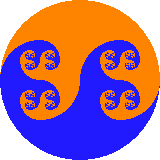
I am a computer engineer by formation (although I also did some philosophy...). I use computers as a tool to study complex systems. Complex systems have interactions between elements that affect the state of the elements. Thus, it is difficult to reduce the behavior of the system to the behavior of the parts, since the interactions are relevant. Simulations are a good alternative to traditional approaches, since much of the behavior of complex systems is not reducible, i.e. it cannot be deduced beforehand. You need to run the simulation and then try to explain it. I use as tools agent-based modeling, cellular automata, and similar approaches.
These tentative projects are intended to explore collaborations with colleagues and to help prospective students and collaborators in finding a topic they would like to work with. They are in no way limiting, i.e. I can work on topics not listed here, if they are interesting enough.
This list is a bit outdated, you should see our latest publications for updates.
I study self-organizing systems mainly with a simulation-based approach. I use the following methodological principle to design self-organizing systems: Minimize local friction to achieve global satisfaction.
See previous work on self-organizing systems.
We've had very good results in simulations of self-organizing traffic lights, where they show a considerable improvement over the traditional green wave method. There are many directions in which this work can go: to use the method to study the effect of priority vehicles (combined with a simulation of a bus rapid transit system), improving the self-organizing method, improving the simulation, and implementing the method in a real city.
See: Gershenson, C. (2005). Self-Organizing Traffic Lights. Complex Systems 16(1): 29-53. [preprint]
Cools, S.-B., C. Gershenson, and B. D'Hooghe (2007). Self-organizing traffic lights: A realistic simulation In Prokopenko, M. (Ed.) Self-Organization: Applied Multi-Agent Systems, Chapter 3, pp. 41-49. Springer, London.
We are exploring self-organizing algorithms to regulate vehicles in public transportation systems, preventing the equal headway instability phenomenon.
See: Gershenson, C. and L. A. Pineda (2009). Why Does Public Transport Not Arrive on Time? The Pervasiveness of Equal Headway Instability. PLoS ONE 4(10): e7292
See also: Dirk Helbing, Illés Farkas, and Tamas Vicsek: Simulating dynamical features of escape panic. Nature 407, 487-490 (2000).
See: Gershenson, C. (2008). Towards Self-Organizing Bureaucracies, International Journal of Public Information Systems, 2008(1):1-24.
The concepts from self-organizing systems can be useful in urbanism. There are many possible avenues of research, which can apply the methods to study other systems in order to find adaptive and robust solutions to urban problems.
See also: Juval Portugali (2000) Self-Organization and the City, Springer.
Self-organizing urban transportation systems.
The principles presented above can also be used to design computers (theoretical and actual) that can perform computations while adapting to changes of internal and/or environmental conditions.
Random Boolean networks (RBN) are powerful computational models of genetic regulatory networks, first proposed by Stuart Kauffman. They are very general, and are actually a generalization of cellular automata. There is great interest in studying RBNs as computational models as well as using them to understand biological properties such as robustness, adaptability, evolvability, neutrality, modularity, degeneracy, etc..
See previous work on random Boolean networks.
What we know about the world affects how we see the world. Thus, scientific advancements affect philosophical ideas. There are several philosophical aspects that have been revolutionized by the scientific study of complex systems. There is still much more to go.
See:  Gershenson, C., D. Aerts, and B. Edmonds (Eds.). (2007). Worldviews, Science, and Us: Philosophy and Complexity. World Scientific, Singapore.
Gershenson, C., D. Aerts, and B. Edmonds (Eds.). (2007). Worldviews, Science, and Us: Philosophy and Complexity. World Scientific, Singapore.
Gershenson, C. and F. Heylighen (2005). How can we think the complex? In Richardson, Kurt (ed.) Managing Organizational Complexity: Philosophy, Theory and Application, Chapter 3. Information Age Publishing.
Gershenson, C. (2002). Contextuality: A Philosophical Paradigm, with Applications to Philosophy of Cognitive Science. POCS Essay, COGS, University of Sussex. [pdf], [html]
Gershenson, C. (2002a). Complex Philosophy. Proceedings of the 1 st Biennial Seminar on Philosophical, Methodological & Epistemological Implications of Complexity Theory. La Habana, Cuba. Also in InterJournal of Complex Systems, 544.